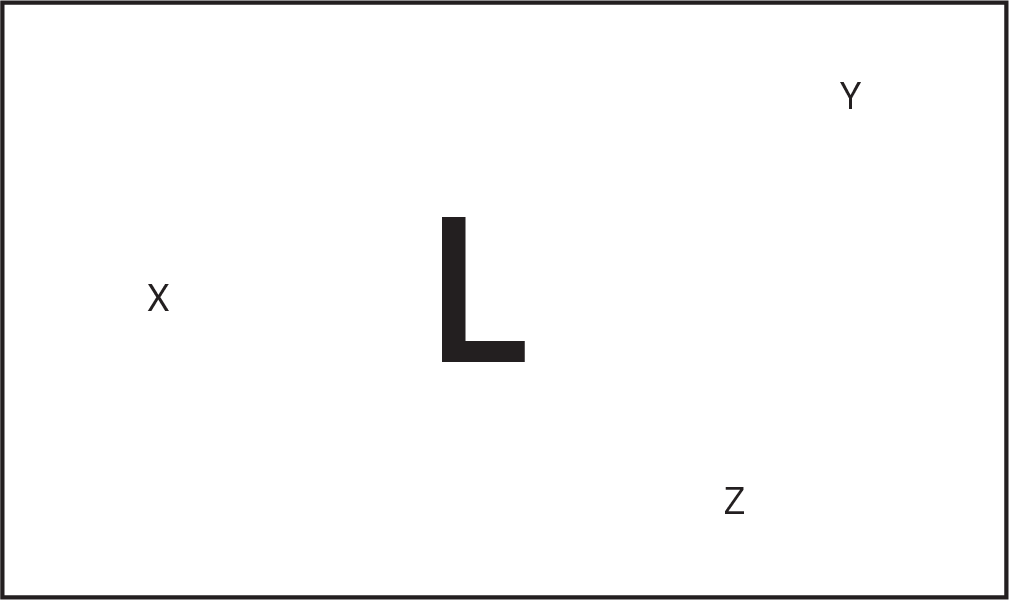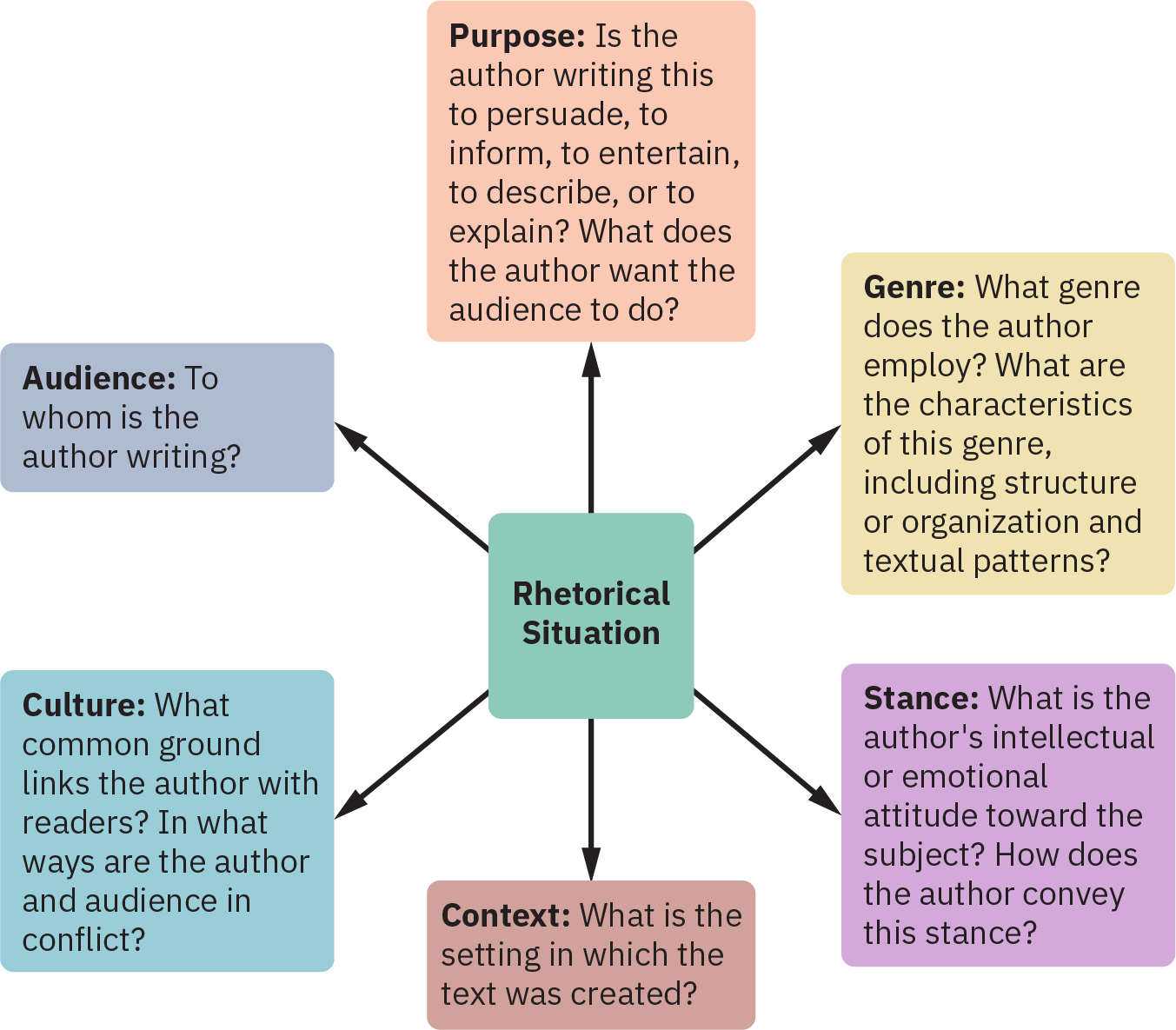Reading Critically
Another Perspective

Activity
As a class or in small groups, agree on a short text to read and respond to.
- First, read it completely for understanding. Summarize or paraphrase the main ideas of the text to check for comprehension.
- Second, read it critically to determine its purpose, to analyze its use of language (or another element), and to evaluate it.
- Finally, write a short (1–2 pages) critical response to the text, perhaps recommending or not recommending it to other readers, explaining its significance in a particular area of life or field of study, or even commenting on the diction or style of the communication and its potential impact on readers
Share your responses in small groups, paying particular attention to the evaluation, analysis, and evidence that each person presents. Revise your initial response based on these new, shared perspectives from your classmates about the same text. The goal is to learn from others’ perspectives. In so doing, consider how your classmates’ perspectives enhance your comprehension and broaden your ability to understand the interpretations of the text.
As you revise, incorporate this new knowledge, and consider how the various cultures and interpretations based on culture can lead to understanding and even misunderstanding. Pay attention to how you might consider these multiple perspectives to clarify the text’s purpose or meaning for an audience.
Thinking Critically About a Text

- understand what it means within its rhetorical situation;
- analyze its meaning;
- evaluate its significance; and
- determine how to incorporate it into your own thinking and writing.
Ways to Interact with a Text
Responding to Understand: Summary
A summary is a condensed version of a longer text that reviews its main ideas. Shorter than the original text, a summary is written in your own words. To prepare a summary, you may outline or annotate the text to highlight relationships between ideas or conclusions. Reread sections of the text such as abstracts, first and last paragraphs, and sections titled “Summary,” “Observations,” or “Conclusion(s).” Also consider headings, subheadings, and visuals, all of which often name main ideas. Remember, you want to provide a summary in your own words of the source’s work, not your interpretation or opinion of it. Review this video on summarizing for more information.
Responding to Clarify: Paraphrase
A paraphrase is a restatement of a text or part of a text, written in your own words, to clarify its meaning for your readers. A paraphrase is usually about the same length as the original text, although it can be either longer or shorter. Your goal in paraphrasing is to provide readers with clarity about a complex idea while still maintaining the perspective of the source. Paraphrasing can be difficult and requires practice, so be sure to review Examples of Paraphrasing without Plagiarizing.
Responding to Analyze
Responding to analyze means moving beyond a basic understanding and appreciation of what the text says and examining it to see how it was put together in order to deepen your comprehension. From thorough analysis, you can arrive at your own theory regarding what the text means. Thus, analysis leads to interpretation and to evaluation, or judgment of its merits.
In responding to analyze, consider the following questions: How has the author constructed this text? What is the author’s subject, tone, and message or theme? For what reason or purpose has the author constructed this text in this way at this time? An analysis provides an understanding of the ways in which the parts of the text form a whole within a rhetorical situation. Any such response points to important ideas and makes connections to provide textual evidence to support the analysis.
To read a text analytically, mark it for
- points of agreement and disagreement with claims or assertions;
- convincing examples that support claims or assertions;
- implications or consequences of believing the author;
- personal associations with text material;
- connections to other “texts” you have read;
- recurring images, symbols, diction, phrases, ideas, and so on; and
- conclusions.
Consider developing a coding system for cross-referencing to show that one annotation, passage, or idea is related to another. Some students write comments on different features of the text in different colors, such as green for nature imagery, blue for key terms, red for interesting anecdotes, and so on. Other students use numbers, such as 1 for plot, 2 for character, and so on.
Responding to Evaluate
Responding to evaluate means deciding whether you think the text accomplishes its purposes effectively. In other words, does the text do what it claims to do? You can also determine the significance of the text and its implications. Of course, different genres of texts should be judged using different criteria. To evaluate a text, you need to understand and analyze it in order to support your judgments.
An informational text presents facts and draws conclusions based on those facts. When responding to an informational text, ensure that the facts are accurate, that the inferences rely on facts, and that opinions presented as evidence are based on expertise, not emotion. Decide whether the author presents enough reliable facts to justify the conclusions. In addition, consider whether the author is reliable and reasonable. Also, ask questions, such as Is the tone objective? Has all the relevant information been presented? Is the author an expert in the field? What necessary or useful information seems missing? Are other perspectives missing?
To understand an informational text, you need some context for the new ideas you encounter, some knowledge of the terms and ideas, and knowledge of the rules that govern the genre. It would be difficult to read the Emancipation Proclamation with no knowledge of the Civil War (1861–1865) or the practice of enslavement. It would also be difficult to read a biology textbook chapter about photosynthesis but know nothing of plants, cell structure, or chemical reactions. The more you know, the more you learn; the more you learn, the more critical your reading, writing, and thinking will be. As you gain knowledge, you will naturally ask more questions and make more connections or bridges between information sources, thereby enhancing your reading, writing, and critical thinking skills.
Many college instructors will ask you to read about subjects that are new to you. First, of course, it’s important to understand what you read. Comprehension means being proactive as a reader: looking up words you do not know, taking meaningful notes, asking questions, understanding the rhetorical situation of the text, and so on. Second, you want to improve your skills to analyze or evaluate texts critically and write about this understanding. However, how do you develop context, learn background, and find the rules to help you read unfamiliar texts on unfamiliar subjects? What strategies or shortcuts can speed up the learning process?
Actitvity
Read the following statement issued by President Harry S. Truman (1884–1972), take notes, and practice being a proactive reader who focuses on comprehension, the rhetorical situation, and critical analysis of the passage.

How did you do? Did your reasoning go something like this?
- Noting the setting—Hiroshima, Japan. Prior historical knowledge suggests that Hiroshima is one of the cities on which the United States dropped an atomic bomb near the end of World War II (1939–1945).
- Staying with the first sentence, Truman focuses on Hiroshima as something useful to the enemy that has been destroyed. There is no mention of human casualties.
- The second sentence focuses on the destructive power of the bomb, suggesting the force of the United States’s arsenal.
- Out of curiosity, you might have looked up the British Grand Slam to learn it was a powerful bomb type developed by engineer and inventor Sir Barnes Wallis (1887–1979) and used during World War II. Here, too, Truman suggests that the United States is even more powerful than its ally Great Britain.
- The tone of the text is prideful, as if using the largest bomb in the history of warfare is a grand accomplishment.
Whether reading new texts, learning new information, or witnessing unfamiliar events, you usually draw meaning by following a process something like this one—trying to identify what you see, hear, or read; questioning what you do not understand; making and testing predictions; and consulting authorities for confirmation or credible information. In this way, comprehension leads to critical analysis, understanding, and evaluation.
Critical Response: The Case of Jean Gianini (An Annotated Model)
In 1914, in the village of Poland, New York, sixteen-year-old Jean Gianini murdered his former teacher Lydia Beecher. During the commission of this brutal murder, Gianini provided evidence that tied him to the murder through a lost a button at the crime scene. Upon arrest, Gianini confessed to the crime. At the trial, Gianni’s defense lawyers claimed that Gianini was legally insane during the commission of his crime. Psychologist Dr. Henry Herbert Goddard was called to testify as an expert witness.
Here, as the author, Henry Herbert Goddard (1866–1957), analyzes “The Case of Jean Gianini” (1915). The selection that follows demonstrates a framework and an example of a critical response to a text. It has been excerpted for clarity and space.
Introduction
In the introduction to his critical response, Goddard includes the title of the work and a summary of the rhetorical situation. He ends the introduction with a statement of evaluation.
“We find the defendant in this case not guilty as charged . . .”
Such was the verdict by the jury of the Supreme Court of Herkimer County, New York, on May 28th, 1914, in the case of the people vs. Jean Gianini, indicted for the murder of Lida Beecher, his former teacher.
Here, the author cites the title of the text—a court case—and provides some early context.
Here, the author provides elements of the rhetorical situation: culture, context, and stance. Shared cultural assumptions are that the guilty will be punished. Contextual details of the trial include a summary of the defense and the jury’s reaction. The phrase “unaccountable to a great many people” may suggest that the author does not agree with the jury’s “not guilty” verdict.
Not infrequently have verdicts in murder trials been unacceptable to the populace. In that respect this verdict is not an exceptional one, but from other standpoints it is remarkable. Probably no verdict in modern times has marked so great a step forward in society’s treatment of the wrongdoer. For the first time in history psychological tests of intelligence have been admitted into court and the mentality of the accused established on the basis of these facts.
The value of this verdict cannot be overestimated. It establishes a new standard in criminal procedure.
Here, the author offers commentary about the larger meaning of this case, historically. In addition, the author concludes with a statement of evaluation—the importance of the verdict to the administration of justice.
Body
The next several body paragraphs provide Goddard with the opportunity to offer the reasons behind his evaluation. Each paragraph should have a topic sentence to maintain focus and organization. For each reason offered, explanation of its importance and supporting evidence from the text through quotations, summaries, or paraphrases should follow.
In this passage, the author gives one reason to support both his and the jury’s assessment of Jean’s intelligence—an intelligence test. Moreover, it is presented as a new scientific tool, which it was in 1915, to help establish the case.
Here, the author introduces evidence from the test through summary. Yet, he employs some faulty cause-and-effect reasoning. Based on Jean’s response to repeating a sentence, is it possible that he refuses to participate in the tests rather than that he is unable to produce the desired responses? By not considering alternative conclusions (or perspectives), the author shows a bias against Jean and favoritism toward the test and the conclusion he draws from it.
Conclusion
To conclude, Goddard shares with readers his final thoughts about the text and leaves the readers with something to think about.
Our general studies have not yet gone far enough, and certainly our study of this particular family is far from sufficient, to enable us to decide whether this is a matter of heredity or whether we shall say that Jean’s condition as well as that of the first child is traceable directly to the mother’s insanity or to her alcoholism.
For the present purpose, of course, it does not matter. We see in these facts, whether we regard them as causes or merely as symptoms of a deeper lying cause, sufficient reason for Jean’s [intellectual condition. [. . .] The next important question that arises is a legal one of whether [. . .] he knew the nature and quality of his act and that it was wrong.
Finally, the author introduces subsequent (and maybe distracting) information. Additionally, the author concedes to the popular assessment of Jean’s mental condition, but he raises a legal question that prompts readers to continue thinking: Does one’s intellectual capacity excuse one from criminal culpability?
LICENSE AND ATTRIBUTION
Adapted from Michelle Bachelor Robinson’s, Maria Jerskey’s, and Toby Fulwiler’s “Chapter 1: The Digital World: Building on What You Already Know to Respond Critically” of Writing Guide with Handbook, 2023, used according to CC BY 4.0.

